Mark Sisson's Blog, page 255
July 17, 2015
I’ve Never Felt This Good in My Entire Life
It’s Friday, everyone! And that means another Primal Blueprint Real Life Story from a Mark’s Daily Apple reader. If you have your own success story and would like to share it with me and the Mark’s Daily Apple community please contact me here. I’ll continue to publish these each Friday as long as they keep coming in. Thank you for reading!
 Every month it came like clockwork, my period, and it felt like a huge slap in my face. It served as another reminder of how my body was not working. We were trying for our second child and the months kept slipping away. Each passing month making me feel more depressed. Add in trouble breathing, swollen painful joints, bleeding cracked hands, mysterious bumps on my skin, mood swings, and 15 pounds that piled on seemingly overnight, I was a mess. I felt like I was falling apart both emotionally and physically.
Every month it came like clockwork, my period, and it felt like a huge slap in my face. It served as another reminder of how my body was not working. We were trying for our second child and the months kept slipping away. Each passing month making me feel more depressed. Add in trouble breathing, swollen painful joints, bleeding cracked hands, mysterious bumps on my skin, mood swings, and 15 pounds that piled on seemingly overnight, I was a mess. I felt like I was falling apart both emotionally and physically.
I made an appointment with my family doctor, hoping she could help me with my already diagnosed “unexplained” infertility and everything else that was going awry with my body. Days before my appointment I was running with a friend, “Do you have asthma?” she asked as I wheezed my way up a hill. I always got really winded running. She expressed concern. Apparently I was one of the worse sounding runners she had ever heard. She had just completed a “Whole 30” with great results and urged me to try. I borrowed the copy of her book. Desperate to try something I almost read the entire book overnight and started the next morning.
Within a day’s time I was already feeling better. Three days later at my doctor’s appointment, I was already down six pounds. A gash on my shin that refused to heal for months had healed. So much so, I even forgot to bring it up and it was a top concern. I had already gone gluten free seven years before. She felt I had additional food intolerances. She said the rapid weight loss showed I was retaining water and probably had widespread inflammation. Later blood work showed that she was correct. She encouraged me to embrace this new way of eating. She believed it would take care of my fertility issues and that was all the encouragement I needed.
During my “Whole 30” I stumbled on to your website. I’m now an avid reader of both the website and your books. It makes Primal doable for me everyday. I feel like Sara 2.0. I feel stronger, braver, happier, and smarter. I call it “skipping on a rainbow” because that’s how good I feel. I’ve never felt this good in my entire life.
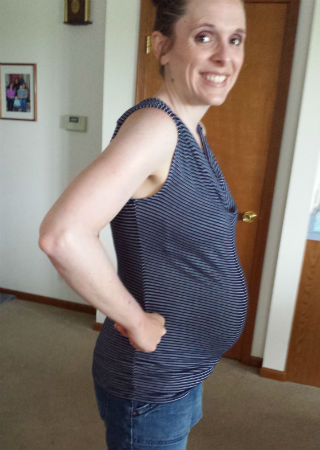 I can write about how I dropped eight pant sizes, more than 30 pounds, and feel more young and vibrant than when I was a kid. All my health concerns are gone. Can you believe this is not the best part of my story?
I can write about how I dropped eight pant sizes, more than 30 pounds, and feel more young and vibrant than when I was a kid. All my health concerns are gone. Can you believe this is not the best part of my story?
While I type this up, my now six month old is happily babbling away on his playmat next to me. It happened! The doctor was right. I went all in with this new eating lifestyle and I got pregnant without any medical intervention. The entire process took me three years. My three year infertility journey took me to a place I couldn’t even imagine, a new pain free life with my beautiful two boys and supportive husband (who discovered he loves broccoli). I also gained my awesome friend who introduced me to this Primal lifestyle and supported me 100 percent.
Can I tell you that I conceived because I went Primal? I don’t know. All I know is that I feel awesome and I am rocking my blessing of a sweet baby. That’s all the proof I need.

Sara




July 16, 2015
Instant Access to “The Cert” for Just $1
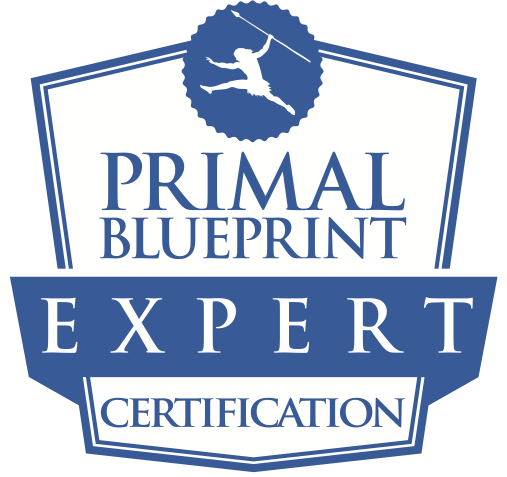 I’m announcing a special offer to everyone interested in the Primal Blueprint Expert Certification program: gain instant access for just $1 down. But more on that in a moment.
I’m announcing a special offer to everyone interested in the Primal Blueprint Expert Certification program: gain instant access for just $1 down. But more on that in a moment.
When my team and I released the Primal Blueprint Certification program last year we had high hopes for it. We envisioned it taking the paleosphere by storm and bringing ancestral health principles deep into the mainstream. With a strong team of experts, we could reach so many more people, change so many more lives, and expand our community ten-fold.
The feedback has been tremendous and positive, and has surpassed my expectations. Hundreds of Primal enthusiasts have completed the course, graduated, and taken their newfound knowledge to their fitness clients, incorporated it into their nutrition programs, introduced it to their medical patients, used it to enhance their business offerings, and made vast strides in their personal health and wellness goals.
Here’s just a handful of the proud grads from across the globe:

There’s Elle Russ (row 11, column 4) who has fine-tuned her own Primal choices (and better health and fitness in the process) and taken her Cert training to the next level by coaching others to realize the same successes and incredible quality of life that ancestral/primal living brings.
Jen Richards (row 12, column 3) who’s gone on to create her own Paleo food company, write children’s books based on Primal principles, and create a children’s healthy living show sharing tips, recipes, and interviews on the Primal lifestyle.
Alvin H. Danenberg, DDS (row 3, column 3) who, after 41 years practicing periodontics, began incorporating ancestral nutrition into his patients’ treatment a little more than 2 years ago. It wasn’t until he completed the Primal Blueprint Expert Certification Program that he understood how to integrate stress reduction, restorative sleep, and efficient exercise into a Primal nutrition program for his patients and himself. In his own words, “I can state without hesitation that the Primal Blueprint Certification Program should be part of every healthcare professional’s background.”
Dr. Dana Leigh Lyons, DOM, AP, LAc (row 11, column 3), a Primal veteran, delved even deeper into Primal with the Cert and made it a foundational part of her Alchemist Eating program, which combines Primal principles, holistic medicine, and healing partnership to help patients get where they want to be with eating, food and health.
Jim Beaumont took the practical knowledge in the PB Cert and applied it to his kettlebell strength and conditioning business and martial art school (Idaho Kettlebell Strength and Conditioning).
And so many others, out there changing their lives and the lives of those around them.
I want everyone to have the chance to take the course, whether you’re a coach, teacher, or simply an enthusiast of ancestral health and wellness. I think everyone can gain to benefit, so today I’m announcing the Primal Blueprint Expert Certification Dollar Down Payment Plan.
Put down $1 today and then $89 for 12 consecutive months thereafter.
It’s easier than ever to invest in yourself and become a Primal Blueprint thought leader.
Click here to find out more about the program or to order and gain instant access.




July 15, 2015
5 Ways to Get the Most Bang for Your Workout Buck
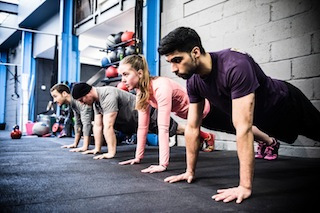 Late last year, I introduced the idea of the minimum effective dose: the lowest dose to produce a desired outcome. Whether it’s calorie intake, exercise, sunlight, carbohydrates, or work habits, we often think we need much more than we actually do to get the results we want. Why crank out those extra reps, put in those extra few hours, choke down another chicken breast if they won’t make you any more prepared to handle what life dishes out? Failing to heed the minimum effective dose costs you money, time, and mental real estate. Figuring out the minimum effective dose for the various inputs shaping our days can make us more efficient and open up the rest of our life to do the things we actually want to do.
Late last year, I introduced the idea of the minimum effective dose: the lowest dose to produce a desired outcome. Whether it’s calorie intake, exercise, sunlight, carbohydrates, or work habits, we often think we need much more than we actually do to get the results we want. Why crank out those extra reps, put in those extra few hours, choke down another chicken breast if they won’t make you any more prepared to handle what life dishes out? Failing to heed the minimum effective dose costs you money, time, and mental real estate. Figuring out the minimum effective dose for the various inputs shaping our days can make us more efficient and open up the rest of our life to do the things we actually want to do.
What, exactly, are the minimum effective doses for exercise? How little do I have to train to stay and/or get fit? And what kind of effects can we expect to get from said minimal doses?
The answers to those questions will depend on who’s asking, but we have a few specific examples of people maintaining, improving, or radically transforming their fitness levels with minimum effective doses of exercise. Let’s take a look.
1. To maintain cardiovascular fitness.
Cardiovascular de-conditioning during the off season is a big issue in cardiovascular-intensive sports like soccer. The last thing many athletes want to do after a grueling season is to resume even more-grueling training on a regular basis. Understandable, but then they come back a couple months later and suck wind for a few weeks until they’ve regained their endurance. What if there were a quick and dirty, efficient way to train and maintain your endurance in the off-season — or any season, for the average person who doesn’t want to work out more than he has to work out?
In 2014, semi-pro soccer players were placed on one of two off-season training regimens:
High intensity interval training, once a week.
High intensity interval training, once every two weeks.
Both HIIT regimens used identical training loads, and it was fairly brutal: five 4-minute high intensity rounds at 87-97% of maximum heart rate. No mention of rest intervals, but I’d imagine they were at least several minutes long to allow them to recover sufficiently. Whether they did it every week or every two weeks, the soccer players maintained their VO2max. There was no cardiovascular advantage to doing it every week. Those biweekly sessions would have been miserable, but they were over pretty quickly, leaving the soccer players plenty of time to work on sport-specific skills and other forms of training (or, you know, reading, going out to dinner with friends and family, hiking, watching good movies, etc). In fact, those players running HIIT every other week also trained a couple hours every week, mostly strength training; the every week group trained over five additional hours a week.
2. To improve muscle endurance and aerobic capacity.
We all (think we) know how to improve aerobic fitness: cardio. Whatever that means. But cardio, at least how most people envision it, takes forever and is pretty darn boring. What if you could improve your aerobic fitness while also improving your muscular endurance — the amount of work your muscles can endure, the amount of time you can keep your force output high — in a fraction of the time?
Four times a week for four weeks, adult females performed a single four-minute Tabata protocol with a single exercise. Exercise choices included burpees, mountain climbers, jumping jacks, or squat thrusts. Another group ran on the treadmill for 30 minutes at 85% max heart rate.
After four weeks, their fitness levels were evaluated. While the treadmill group enjoyed a 7% improvement in aerobic capacity, the interval group improved theirs by 8%. And when it came to muscle endurance, the interval group saw massive gains:
Leg extensions: +40%
Chest press: +207%
Situps: +64%
Pushups: +135%
Back extensions: +75%
Most importantly, the women found the Tabata exercise protocols more enjoyable and sustainable than the aerobic exercise protocol. Their “intention to engage” in exercise was higher than in the aerobic group.
All that in just 16 minutes of work a week.
3. To improve overall physical fitness.
What does “physical fitness” mean to you? In my book, it’s a combination of strength, strength-endurance, and aerobic capacity. The ability to go hard, go fast, and go long. A pair of researchers came up with a “7 minute workout” designed to improve these physical capacities in as little time as possible. The exercises are basic, but effective (as is always the case, right?). Each one is to be performed for 30 seconds with 10 seconds of rest in between exercises.
Jumping jacks
Wall sits
Pushups
Crunches
Step-ups
Squats
Dips
Planks
Running in place with high knees
Lunges
Pushups with rotation
Side planks
Solid list of movements, eh? This year, researchers tested the 7 minute workout. A cohort of men and women were divided into three groups. One group did a 7-minute circuit training workout three times a week, another group did a 14-minute circuit training workout three times a week, and the third group was sedentary. The 14-minute and 7-minute groups performed the same circuit exercises; the 14-minute group just did them twice.
Both exercising groups enjoyed improvements in muscular endurance. The males in both groups also got stronger, while the females improved their aerobic capacity. Training for 14 minutes (which is fairly minimal to begin with) wasn’t necessary to obtain results.
4. To increase metabolic health.
You’ve probably heard me discuss mitochondrial biogenesis: the creation of entirely new mitochondria. This is important because mitochondria are the power plants of the cell and ultimately the body. They metabolize fuel and convert it into useable energy. The more mitochondria you have, and the better they work, the more fat and glucose you’re going to utilize. And since energy overload is toxic to our cells and predictive of many disease states (diabetes, inflammatory conditions, etc) having more mitochondria on hand will keep you healthier for longer. How much exercise do you actually have to do to promote mitochondrial biogenesis?
Not a huge amount, but you will probably have to sprint. In the short term, a workout consisting of four 30-second all-out cycling sprints activated mitochondrial biogenesis in the skeletal muscle of human subjects in one study. Shorter sprints work, too. In fact, a program consisting of three sets of five 4-second (yes, four seconds!) treadmill sprints with 20 seconds of rest in between each sprint, done three times per week for four weeks up-regulated molecular signaling associated with mitochondrial biogenesis. You could do that during a commercial break.
I’ve also talked about the importance of maintaining good insulin sensitivity and how exercise can hep in that regard. Turns out that it doesn’t take much to see a positive effect. Research indicates that four to six 30 second bouts of all-out sprint cycling with four minutes of rest done three times a week improves insulin sensitivity in already-active and sedentary young adults. Measurements were taken 72 hours post training, just to be sure that the improved insulin sensitivity wasn’t a result of acute exercise effects. That’s 6-8 minutes a week of actual work for massive improvements.
5. To control blood sugar.
Visit most fitness communities online and walking gets short shrift. Walking isn’t exercise, they’ll say. It’s a poor substitute for “real” movement that invariably involves grunting, heavy weights, gallons of milk, and chalk. Not to take away from the heavy lifting, because that stuff is indispensable. But walking isn’t useless; it’s essential. There’s even evidence that a tiny amount of walking at a moderate pace — 15 minutes’ worth, to be exact — is enough to blunt the postprandial spike in glucose that can occur in people and lead to real problems down the line. Make that walking “brisk” and you can cut the necessary volume down to a single 21 minute bout while enjoying beneficial effects on postprandial insulin.
So don’t let anyone tell you those short post-meal strolls aren’t helping. They are. They represent a minimal yet highly effective dose of movement that improves your ability to handle blood sugar spikes after meals and regulate your fasting blood sugar throughout the day. More intense, higher volume training certainly improves blood sugar control, too, but a short walk after meals is the simplest, easiest, and most minimal.
Let’s briefly review:
To maintain your cardiovascular fitness, do 5 4-minute intense intervals once every two weeks.
To improve your conditioning and muscular endurance, do standard protocol Tabata burpees (or mountain climbers or any of the other exercises listed) a few times a week.
To become more fit overall, a 7 minute continuous bodyweight workout is sufficient.
To increase insulin sensitivity, go all out on the bike four times for 30 seconds with four minutes of rest, three times a week.
To grow more mitochondria, five 4-second all-out sprints with 20 seconds of rest, three times a week might be enough.
To reduce blood sugar spikes and improve fasting blood sugar, walk for 15 minutes after each meal.
Furthermore, many of these protocols will have crossover effects with each other. You don’t have to — and probably shouldn’t — do all of them, because then you’ve just constructed a high volume training regimen.
Not so daunting, is it?
What are your minimal effective doses for exercise? How little have you gotten away with while enjoying improved health, fitness, and vitality? I’m always looking for ways to cut back on training while retaining the effects, so have at it down below!
Thanks for reading, everyone.




July 14, 2015
Take the 1000 Day Challenge!
 First off: This isn’t the start of a new longer-term Primal Challenge. 1000 days would be fun, but I’m pretty sure we’d run out of ideas — and sponsors. Apologies to everyone out there chomping at the bit for a few years straight of new contests and prizes. You’d get sick of it yourself; trust me. Plus, that shorter 21-day Primal challenge format works because it’s the perfect way to quickly kickstart real change, disrupt bad habits and establish new ones. Today’s challenge concerns long, lasting, sustained, momentous change that happens over a greater timescale.
First off: This isn’t the start of a new longer-term Primal Challenge. 1000 days would be fun, but I’m pretty sure we’d run out of ideas — and sponsors. Apologies to everyone out there chomping at the bit for a few years straight of new contests and prizes. You’d get sick of it yourself; trust me. Plus, that shorter 21-day Primal challenge format works because it’s the perfect way to quickly kickstart real change, disrupt bad habits and establish new ones. Today’s challenge concerns long, lasting, sustained, momentous change that happens over a greater timescale.
Let’s try a thought experiment.
Think about 1000 days. Try to picture it. It’s a long time, isn’t it? Almost three years. A lot can happen in 1000 days. Why, in 1000 days, a person could accomplish any number of things:
Think up a fantasy business idea with pals and actually plan, execute, and bring it to fruition.
Move across the country, even if they walked.
Conceive of and write a book.
Propose, plan a wedding, get married, get pregnant, give birth, and watch your kid take his first steps.
Learn a language.
Hem and haw about whether you really want one before starting and finishing a master’s degree.
Save enough money to travel for a year, travel for a year, and come back home and get settled back in.
Mount and complete an early 19th century expedition across a largely unexplored continent teeming with wildlife and potentially hostile indigenous people that starts in St. Louis, reaches the Pacific Ocean, and ends back in St. Louis without losing more than a single member while being hunted by four teams of mercenaries and soldiers commissioned by Spain.
Design, construct, and successfully test the first atomic bomb.
Start a blog about Primal living from scratch and grow the audience to millions of monthly visitors.
Yep. There’s almost no limit to what you can do. People can achieve incredible things in 1000 days. People have achieved truly monumental things in 1000 days. If you really think about it, you can reach just about any goal – or at least make a huge amount of progress toward it — in 1000 days.
And yet, in the grand scheme of things, in the lifespan of the average human being, 1000 days is a blip. It’s not that long. You get comfortable, allow your existence to grow staid, and dutifully punch the clock on whatever life you’ve fallen into and those 1000 days just slip right on by. They bleed into each other. “What, it’s Thanksgiving already?”
Furthermore, 1000 days is enough time to accomplish almost anything but not so much time that your entire life is wasted if you fail. You can bounce back and learn from your mistakes. “Well, that didn’t work. What’s next?” Some people bounce back after forty years in prison, and you’re worried about 1000 days?
All those hopes, those aspirations, those late night conversations about what-could-be? They don’t morph into anything resembling tangible reality all by themselves. If you don’t actually start the process, your dreams will remain fun thought experiments that elicit brief sensations of excitement. That’s not good enough for you, nor for anyone. Luckily, you’ve got 1000 days to get going. To get somewhere.
Okay, let’s move on to a doing experiment. Time to transcend mere thinking and imagining. Time to do.
Put a big fat X on October 3, 2018 (or set an alarm on your phone, arrange an email alert, etc). That’s 1000 days from now. What are you going to complete by that date? What will you change, learn, become? Who will you be? Where will you be? What have you always wanted to accomplish but have yet to even begin approaching?
That business idea you’ve mulled over for months now, the one that gives you the butterflies every time you allow yourself the luxury of imagining it? For that brief moment, your brain is convinced you’re actually living it. You’ve tricked yourself into treating the fantasy as reality. Then it comes crashing down. Felt good, right? Get on it. You’ve got a 1000 days.
So you’re 150 pounds overweight, nothing fits, you can’t handle the mirror, and a single flight of stairs is a conditioning workout. It’s hard, but get over it. Start today. People have been there. People have made it out in less than 1000 days. Be another.
You hate your job, or maybe you just know you’d be happier doing something else. Only problem is you need a specific type of training to shift careers. Maybe it’s a class. Maybe it’s a 2-year degree. Maybe it’s an apprenticeship or a certification. Maybe it’s simply a matter of buying a few books, perusing a few websites, and really buckling down to teach yourself. The point is that you know what needs doing, so use these 1000 days to do it.
That fitness goal. You know, that one that always seemed possible (because so many others can do it) but complex and difficult enough that you never got around to seriously trying, let alone mastering it. Is it a handstand pushup? A twice bodyweight squat? Hiking the Appalachian trail?
That home gym you saw on Pinterest last year, the one you shared on your Facebook wall? Remember how you half-assedly filled a shopping cart on HomeDepot.com with materials to actually build it, then did nothing? Perhaps it’s time to resurrect that “plan” and make it a real plan.
Forget the “ten year plan,” or the “five year plan.” Downsize those puppies down to 1000 days. (Or, if you’re really driven, you can lisen to PayPal founder Peter Thiel and condense them down to six months.)
Lots of goals will be more open-ended or less rigorously defined. “Be happier.” Or “live life.” That’s fine. You can still work toward an amorphous goal like “be happier” by doing things that make you happy.
It could be all or none of those things. We all have something, though. Shake yourself from reverie and seize the (1000) day(s). It’s plenty of time but only if you use it.
How are you going to tackle this challenge? Have you attempted a similar challenge in the past? How’d it go?
Thanks for reading, all. I can’t wait to hear back from all of you on October 3, 2018!




July 13, 2015
Dear Mark: Ketosis and Testosterone, Dehydration Hormesis, and Isomalto-Oligosaccharides
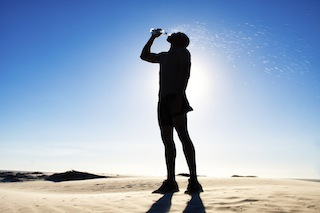 For today’s edition of Dear Mark, I’m answering three questions. The first one concerns a potentially combative and controversial topic: ketogenic diets. What’s the deal with their effect on testosterone? You can find keto anecdotes across the web both inspiring and flaccid, but what, if anything, does the science say? Next, might there be a way to derive beneficial hormetic effects from acute bouts of dehydration? It seems like every other stressor can actually make a person stronger, so perhaps an otherwise wholly negative one like dehydration might as well. And finally, is the prebiotic fiber known as isomalto-oligosaccharide safe and/or good to eat?
For today’s edition of Dear Mark, I’m answering three questions. The first one concerns a potentially combative and controversial topic: ketogenic diets. What’s the deal with their effect on testosterone? You can find keto anecdotes across the web both inspiring and flaccid, but what, if anything, does the science say? Next, might there be a way to derive beneficial hormetic effects from acute bouts of dehydration? It seems like every other stressor can actually make a person stronger, so perhaps an otherwise wholly negative one like dehydration might as well. And finally, is the prebiotic fiber known as isomalto-oligosaccharide safe and/or good to eat?
Let’s go:
Mark,
There is a ton of conflicting information on the internet about whether the standard ketogenic diet increases or decreases testosterone levels. What is your opinion?
Thanks,
Adam
In women with PCOS, a ketogenic diet lowers testosterone. Sounds bad, right? In PCOS, lower testosterone is actually an improvement as the disease is characterized by unnaturally high testosterone levels. What about in men, the population worrying about T levels most — does keto improve testosterone in them, too?
Unfortunately, there aren’t many studies that examine the effect of ketogenic diets on testosterone in males. We have a bit of data about the opposite — an increase in carbs and a reduction in fat. In an older study, men who customarily ate a 40% fat diet were placed on a 25% fat diet; the lower-fat diet also had a higher PUFA/SFA ratio and more fiber. Their total and free testosterone levels were measured pre- and post-intervention. After going l0wer-fat and higher-carb, total T dropped from 22.7 to 19.3 and free T from 0.23 to 0.2. Resuming their old diets partially restored their lagging T levels. Again, this isn’t a keto diet study, but it gives us a small inkling. Higher-fat, lower-carb appears to be safe and perhaps beneficial for testosterone.
Another study in men compared a higher-fat (41%, PUFA/SFA ratio of 0.6) diet to a lower-fat (18.8%, PUFA/SFA ratio of 1.3) diet, finding that serum T was 13% higher on the higher-fat diet. Both diets were calorie matched.
But neither of these papers looked at ketogenic diets. Low-carb just isn’t the same as full-blown ketosis. We can’t extrapolate. So let’s speculate.
How ketogenic dieting might both lower and raise testosterone: Ketogenic diets tend to be inadvertently hypocaloric, which is why so many people have so much success using them for weight loss. When you eat fat and protein to satiation, reduce carbs, and avoid hyperinsulinemia, your appetite normalizes and you’re actually able to tap into stored body fat for energy. For many people, this makes it hard to eat as many calories as before. This is great if you want to lose weight. Indeed, in obese men, a low calorie diet will improve sexual function and raise testosterone. The effect of weight loss (and consumption of many thousands of calories in stored body fat to make up for the “missing” food) is enough to boost testosterone production.
If you’re lean, the effect likely changes. You don’t have the luxury of eating pounds of your own body fat. Ultra low calorie diets – which for some, ketogenic diets become – take their toll on hormonal health. Lots of the CRON crowd — the calorie restriction for longevity guys — suffer from poor libido, likely stemming from low testosterone levels. Also recall what happens to the hormonal profile of bodybuilding competitors as they approach competition and embroil themselves in heavy training and dieting. Their testosterone plummets.
As I’ve said before, I’m suspicious of chronic ketosis for most people. I’ve heard incredible stories from people who thrive on it, but I’ve also heard disappointing reports from people who’ve failed. What seems to be a safer bet for almost everyone is spending some time in ketosis, not all of it. Everyone can probably benefit from short dalliances with the ketogenic state. Most people don’t need to remain ketogenic for perpetuity, and they might even suffer for it.
The effect ketogenic dieting has on testosterone comes down to a few things, most likely:
Are you eating enough food?
Are you consuming testosterone-supporting nutrients like zinc, cholesterol, magnesium, saturated fat, and vitamin A?
Are you noticing any negative changes in libido?
Are you using it to lose weight — and succeeding?
I’d love to hear from people reading this: how has ketogenic dieting affected your testosterone?
Hi Mark,
Been a long time reader. Found a lot of your articles to be very enlightening and thoughtful. For example, after reading your write-up on sauna health benefit, I’ve been striving to go use sauna 2-3x a week. In a related note, after profuse sweating from working out and sauna usage, I am generally pretty dehydrated. Normally I’d drink some water from the fountain at the gym to rehydrate, but I was thinking if there would be any health benefit via hormesis from temporary acute dehydration. My home is 20 mins away from gym, so it’s not long I’m putting my body in a period of stress. Plus, I have more options of rehydration once I get home. Like to know your thoughts. Thank you.
Cheers,
Charles
It may be that short, targeted bouts of acute dehydration improve kidney function. Most research finds that the harder a person exercises, the better their kidney clears creatinine from the blood. Pro cyclists, for example, regularly dehydrate themselves over the course of a race and have better GFRs (glomerular filtration rate, a measure of kidney function) than recreational cyclists and sedentary people.
Whatever you do, don’t feel the need to “drink ahead” of your thirst. By all indications, an athlete’s performance actually suffers when they try to stay ahead of their thirst by drinking before they feel thirsty. Those who use thirst as a guide to hydrate enjoy better performance than those who drink before thirsty or ignore their thirst.
I don’t think you need to abstain from water after a workout. I think you should just replenish your fluids when thirsty. The stress you experience training while thirsty is probably enough to provoke an adaptive response, if one’s going to occur.
For me, I’m rarely thirsty in the middle of a workout, but I’m definitely parched immediately after. My guess is it’s worked, since I can hold my own without constant access to water.
Still, be very careful with this one. Most people would think you’re crazy to even try, but I doubt it’ll hurt. If you’re really dehydrated, you can always stop for a drink along the way (or keep a bottle of water on hand).
Dear Mark,
As a 19-year-old in the digital age, the humor is not lost on me as I type this–asking your opinion on something called isomalto-oligosacchardies (IMO)–when the abbreviation “imo” is commonly used among my peers to communicate the phrase “in my opinion.”
Anyway. IMO: Stumbled across a recipe that called for this stuff. The brand was “VitaFiber.” The blogger touted the ingredient for being an alternative sweetener that is not a gut-disrupting sugar alcohol. In fact, as the name would suggest, it provides prebiotic fiber. I’ve read that it can be made from starch derived from just about anything. I’m assuming IMO made from grains would be out then. But what if it was from tapioca?
imo…tbh (to be honest)…the amount of experimental paleo baking I do, combined with my love of fruits, I’d like an option for sweetening a treat without necessarily relying on raw honey or grade B maple syrup. I know this is like the holy grail for primal beings like me with a stubborn sweet tooth and vivid memories of wheat/sugar/junk-based desserts & candy. So I understand if you’re sick of the sweetener questions. With the overwhelming number of options out there, and all of the businesses looking to dominate the market, I haven’t dwelled too much on the topic myself. I haven’t tried stevia yet, which seems to be one of the more primal-approved options. But I often wonder whether there is in fact a good (not just decent) human diet “hack” for this issue.
Many thanks for your time and all that you do.
Emma
Isomalto-oligosaccharides aren’t common in nature, which makes people wary. That’s understandable. But we should do our due diligence and really look at the evidence before condemnation or celebration. Let’s do that now. What does the research say about IMO?
They can feed bifidobacteria and lactobacillus strains.
They can improve bowel function and increase short chain fatty acid production in the gut in constipated elderly men.
On a long-term (relatively; 8 weeks) IMO regimen, elderly on an otherwise low-fiber diet enjoyed improved bathroom experiences, beneficial changes to gut bacteria composition, and better blood lipids.
In dialysis patients, IMO supplementation improved bowel function and raised HDL while lowering triglycerides and total cholesterol.
In rats treated with a chemotherapy drug, IMO supplementation reduced its toxic effects via increased butyrate production.
They improve host immunity in mice.
IMO seems fine and even beneficial, IMO. For those not interested in messing around with VitaFiber, Quest Bars use isomalto-oligosaccharides. As far as commercial protein bars go, the Quest ones aren’t half bad. Whey isolate, stevia to sweeten, various whole food ingredients (cocoa, nuts, etc), plus the isomalto-oligosaccharides? You could do worse.
That’s it for this week, everyone. Thanks for reading and be sure to weigh in with your thoughts and responses down below!




July 12, 2015
Weekend Link Love – Edition 356

Check out the new trailer for We Love Paleo, the upcoming documentary about ancestral health.
A condensed guide to Dr. Ron Sinha’s South Asian Health Solution: because time is a precious resource these days.
Research of the Week
Type 2 diabetes does a number on the brain.
Hikes improve mental health and may fight depression.
Parkinson’s disease may start in the gut.
New Primal Blueprint Podcasts

Episode 75: Dr. Gary Foresman: Host Elle Russ hangs out with Dr. Gary Foresman, a formerly traditional physician who revolutionized his approach to patient care by incorporating lifestyle, ancestral health, massage, stress management, and other “alternative” therapies into his practice. It’s always interesting to hear from people who walk two worlds — conventional medicine and integrative medicine — and Dr. Foresman is one of the best.
Each week, select Mark’s Daily Apple blog posts are prepared as Primal Blueprint Podcasts. Need to catch up on reading, but don’t have the time? Prefer to listen to articles while on the go? Check out the new blog post podcasts below, and subscribe to the Primal Blueprint Podcast here so you never miss an episode.
10 Primal Foods You Aren’t Eating Enough Of
Is the Paleo Diet Supported by Scientific Research? — Part 2
Also, be sure to check out and subscribe to the (relatively) brand new Primal Endurance Podcast.
Weekly sweepstakes: Write a review for The Primal Blueprint Podcast or The Primal Endurance Podcast on iTunes and submit this form for a chance to win a Primal prize package. One new winner is chosen every week!
Interesting Blog Posts
If you’ve got tight hips and/or quads (which you probably do), try the exercises in this VitaMoves video.
How climbing supports shoulder health.
While melatonin can help people re-establish circadian rhythms and combat jetlag, it probably shouldn’t be given to kids.
Media, Schmedia
From the New York Times, is it the gluten, or is it the poor state of our gut health? And Dr. William Davis’s response.
Can’t sleep? Watch this video.
Everything Else
Darryl Edwards has just released Paleo from A to Z, an intuitive paleo lifestyle encyclopedia that manages to be both accessible and in-depth. Check out the trailer and pick up a copy.
The fish kick might be the fastest swim stroke ever.
Could a simple eccentric hamstring exercise prevent the majority of hamstring injuries?
Cats: true carnivores.
Have we built a sickness care system?
Tennis ball meets tennis racquet, in slow motion.
Recipe Corner
Dr. Al Danenberg’s favorite Primal burger recipe. Not bad for a dentist (just kidding; I’m not an anti-dentite).
You’d never think to combine rooibos tea, apricots, and thyme, but it’s really tasty.
Time Capsule
One year ago (Jul 14 – Jul 20)
9 Signs You Need to Eat More Fat – How to know when you need more (or different) fat in your diet.
Reframing Your Definition of Affluence –Affluence isn’t necessarily defined by the contents of your bank account.
Comment of the Week
All right, I’ll pull out the blackstrap molasses, and then the Nair for the hair it’ll put on my chest.
Nair is primal too, right?
– That’s how I do it.




July 11, 2015
Spanish Fried Eggs
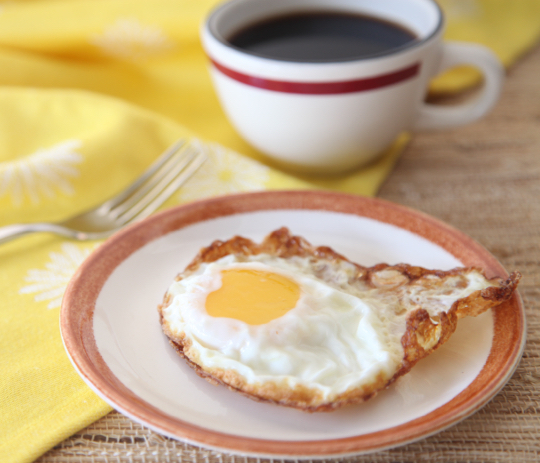
There’s only one reason to fry an egg in very hot extra virgin olive oil, and it’s a good one. This type of fried egg is often called “Spanish style” and there’s no arguing that it’s not delicious. The edges are so crispy, they shatter in your mouth. The white is soft and pillow-like and the yolk is warm and runny. The egg needs nothing more than salt (and maybe a dash of hot sauce) to be a memorable meal.
Once you’ve tasted a Spanish fried egg, you might never want to go back to rubbery, bland fried eggs again. But then there’s that issue of high heat oxidizing extra virgin olive oil, making it a poor choice for high heat cooking. Or is it?
When using this hot and quick method, the egg is in and out of the pan in less than two minutes. And there’s no need to get the oil so hot that it’s smoking. So a Spanish style fried egg is not likely to turn extra virgin olive oil into a health threat. And the truth is, no other fat works quite the same magic on a fried egg.
Coconut oil doesn’t deliver the same crispiness and it affects the flavor of the egg. Butter browns and starts to burn before the egg gets really crispy. Lard makes a good fried egg, but it doesn’t make a great Spanish style fried egg. The edges just don’t get as light and crispy as they do with olive oil. So, maybe a Spanish style fried egg isn’t something you eat every morning for breakfast, but if you don’t’ try it at least once, you’re missing out.
Servings: 1
Time in the Kitchen: 5 minutes
Ingredients:
1 egg
3 tablespoons extra virgin olive oil, or enough to have about 1/8” in the bottom of the skillet
Instructions:
Crack the egg into a cup.
Heat a small skillet over medium-high until it’s very hot. Add the olive oil. When the oil is hot (but not so hot that it’s smoking) gently slide the egg into skillet (watch out for hot oil splatters when the egg hits the skillet) The oil should be hot enough to make the edges of the egg start bubbling immediately when it hits the pan.
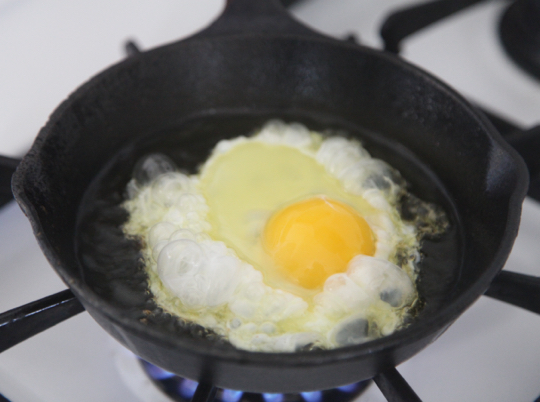
Cook the egg for 2 minutes or less, until the white is very crispy around the edges and puffed up around the yolk. If the edges of the egg are starting to burn or the oil seems on the verge of smoking, then turn the heat down slightly.
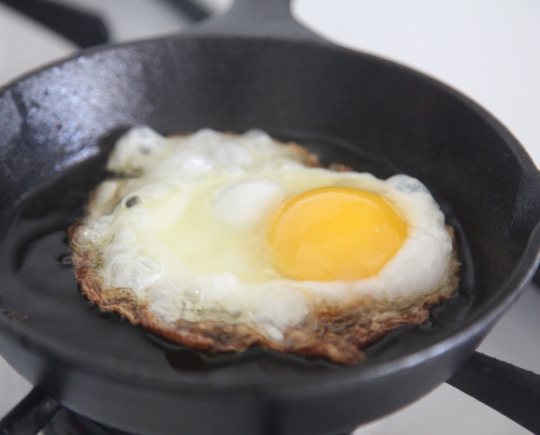
Run a metal spatula underneath the egg to keep it from sticking to the bottom of the saucepan, then slide or lift it out.
Sprinkle with salt and eat immediately.
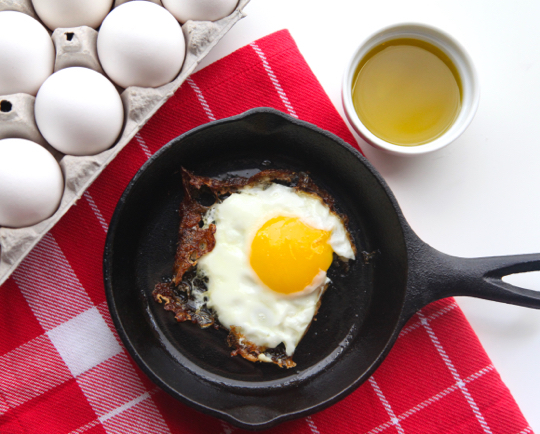
Not Sure What to Eat? Get the Primal Blueprint Meal Plan for Shopping Lists and Recipes Delivered Directly to Your Inbox Each Week. Now Available as an App!



July 10, 2015
From “Skinny-Fat” to the Best Shape of My Life
It’s Friday, everyone! And that means another Primal Blueprint Real Life Story from a Mark’s Daily Apple reader. If you have your own success story and would like to share it with me and the Mark’s Daily Apple community please contact me here. I’ll continue to publish these each Friday as long as they keep coming in. Thank you for reading!
 Long time reader here. First time writer. Writing all the way from New Zealand.
Long time reader here. First time writer. Writing all the way from New Zealand.
I found out about Mark’s Daily Apple and The Primal Blueprint about four years ago. I read some of the pages on it, and was instantly sold that this was how nutrition should be done. I particularly liked the pages describing the insulin response, and the biological mechanisms that happen from relying on carbs as opposed to fats. I became a subscriber to the MDA RSS feed and have read or skimmed every post since then.
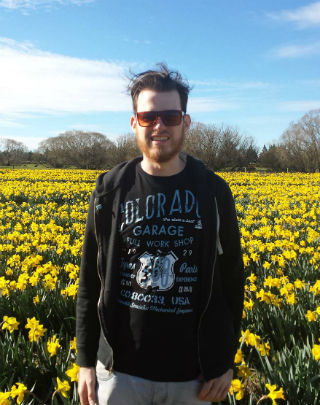 Some background about me. I was, at the time of this photo, skinny-fat; 185 cm tall (approximately 6′ 1″) and 85 kg (187 pounds).
Some background about me. I was, at the time of this photo, skinny-fat; 185 cm tall (approximately 6′ 1″) and 85 kg (187 pounds).
Five years earlier at the age of 18, I had been about 75 kg (167 pounds), but a student’s lifestyle of fish and chips had brought me to 85 kg and all my “healthy eating” attempts had never got me much lower than that.
Unfortunately it took me a long time to start the Primal lifestyle. At the time, I was with a partner who was significantly more overweight than I was. I tried to talk to her about Primal, but she viewed it as a fad, wouldn’t read any of the source material, and expressed concerns that my following of the lifestyle would be disruptive of our combined efforts to work on her weight problems. She didn’t look at me as ‘skinny fat,’ but just ‘skinny’ and didn’t see that I needed to diet at all, except to be supportive of her own weight loss.
For the most part I was on board with this. Weight loss would fluctuate on a typical diet depending on how much fast food we would eat, and I would often think about The Primal Blueprint when I ate, and other times I would ignore it. At one point my weight got out of control and I was approximately 95 kg (209 pounds). We both joined Weight Watchers at this point. During Weight Watchers I was able to lose weight, but slowly and with great difficulty. I would often feel very hungry and just bear through it. By the time I finished, I was down to 84.0 kg and unable to lose any more. Eventually I stopped going, and both of our lifestyles became disruptive again.
It may have become clear from this writing that my relationship wasn’t particularly healthy for either of us. Late last year we broke up to our mutual benefit, and I immediately jumped full board onto the Primal bandwagon. I began to cook several days worth of lunches for work, and planned regular body-weight exercise three times a week. Prior to this I was sort of half-doing Primal already, so the transition was fairly painless from a cravings perspective.
Every week I would spend one day doing some squats, one day doing some push-ups, and one day doing some pull-ups. Nothing terribly difficult, but the rule I gave myself is that I always had to do at least as much as the previous week. At first I couldn’t even do a single pull-up, but it all slowly built up with time. All through this process I walked to work each day, and would occasionally go for a run when heading around to friends places and back.
 After five weeks of this, I was both looking and feeling a lot better. I didn’t weigh myself at the start, so I decided to weigh myself then and I was 88 kg. I’m not sure how bad I was when I started. At week 14 I broke the 80 kg barrier. At week 20 I was averaging 76.0 kg. Now it is week 25 and I am about 74.5 kg. For the first time in my adult life I weigh what I did when I was a teenager. Even better, the constant body weight exercises means I have more muscle than I ever did at 18. I am definitely in the best shape of my life.
After five weeks of this, I was both looking and feeling a lot better. I didn’t weigh myself at the start, so I decided to weigh myself then and I was 88 kg. I’m not sure how bad I was when I started. At week 14 I broke the 80 kg barrier. At week 20 I was averaging 76.0 kg. Now it is week 25 and I am about 74.5 kg. For the first time in my adult life I weigh what I did when I was a teenager. Even better, the constant body weight exercises means I have more muscle than I ever did at 18. I am definitely in the best shape of my life.
The best thing of all? I don’t have to count calories at all. I’m barely ever hungry. I have to skip meals to get as hungry as I felt all the time on Weight Watchers. When trying to meet weight loss goals, I have found that I can’t pig out and eat as much as I want, but if I eat small portions until I’m not hungry, I have no problems whatsoever. Occasionally I’ll still have pig-out days, where I eat a whole quiche or something, but I’m always surprised that after a few days my weight hasn’t increased at all. It really is such an easy and effective way to manage your body.
I consider this a huge success for only six months of work, and I am extremely excited to see how the next six months get even better.
Cheers,
Michael




July 9, 2015
Doctors of the Future: 3 Promising Trends in Medical Education
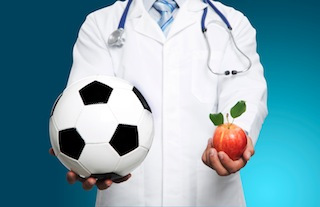 Isn’t it a funny thing when you spend time on a given project (like, say, a blog post) only to find when it’s done that an intriguing new angle shows up in your line of vision? Take last week’s post on health check-ups and how they might be more effective with some strategic re-envisioning. The next day an article on culinary medicine got me thinking about medical training and the myriad of possibilities for physicians who want to enhance their understanding of nutrition, exercise and lifestyle change (and for patients who would prefer a doctor who has this everyday health knowledge).
Isn’t it a funny thing when you spend time on a given project (like, say, a blog post) only to find when it’s done that an intriguing new angle shows up in your line of vision? Take last week’s post on health check-ups and how they might be more effective with some strategic re-envisioning. The next day an article on culinary medicine got me thinking about medical training and the myriad of possibilities for physicians who want to enhance their understanding of nutrition, exercise and lifestyle change (and for patients who would prefer a doctor who has this everyday health knowledge).
We’re looking at two sides of the same coin here really: how “basic”/preventative health care (for most people, ideally the span of insurance qualifying/tax deductible services) can evolve to effectively serve more relevant preventative purposes AND how physician training (particularly for family physicians and general internists) might enhance doctors’ effectiveness in promoting healthy lifestyle and behavior change. In the spirit of this latter point, I wanted to highlight a few unique programs that are breaking through old academic impasses and forging the way toward a new view (and practice) of med school instruction. We the public, I think, may have something to gain here.
Culinary Medicine
There’s the adage, which is thankfully growing in public awareness and research support, that food is medicine. That said, only 25% of medical schools offer their students the 25 hours nutrition science instruction suggested by the National Academy of Sciences. It’s even possible to go through intensive cardiac specialty programs and not receive any instruction on the influence of diet. Meanwhile, the prevalence of obesity, diabetes and heart disease keep rising….
Interestingly, we’re seeing the advent of something called culinary medicine – the study of not just nutrition science but the actual practice of incorporating nutritional principles into hands-on cooking.
The study of culinary medicine is slowly taking root in official and unofficial collaborations between med schools and cooking schools. At Tulane University, for example, med students are required to take a culinary medicine course through Johnson & Wales University. They learn to put healthy cooking into practice while also offering a medical dimension to the culinary science studied by chefs-in-training. Similar collaborative programs exist in other parts of the country, including Chicago.
The med students for their part get to see what healthy and creative cooking look like first-hand. The instruction becomes personal as well as practical. They come away with actual recipes to offer to patients but also with an understanding of what these patients will need to know to make healthy eating happen in their kitchens.
With the decline of food prep in this country, cooking skills are at an all-time sorry state. With programs like these culinary medicine collaborations, nutrition recommendations don’t have to sound from the abstract chamber of book science but can be inspired by real life experience in a gourmet kitchen.
Fitness Medicine
How long have many of us known this – exercise is medicine. Studies have demonstrated its efficacy for countless conditions, including depression. Yet, it’s the most underutilized lifestyle choice out there. Perhaps even more than nutrition, fitness gets short shrift in health check-ups. According to CDC data, only one-third of people who met with a health care provider over the course of a given year received any counsel regarding physical activity.
Most doctors I’ve met know little about exercise science and even less about coaching patients toward an actual, workable plan. One big reason? A large number of doctors don’t exercise.
That’s why I was heartened to read about a fitness instruction program for med students at Case Western University’s Urban Area Health Education Center (and disappointed that it’s no longer running). Dr. Susan Wentz, a trained family physician, directed a program that encouraged exercise as medicine for med school students, noting that students who personally experience the benefits of fitness more often go on to counsel their patients to use exercise for their own health and well-being.
The med students in the program received a 12-week university health club membership as well as initial assessments and partner and class exercise options. Wentz considered it a model for other med schools across the country despite the program’s folding at Case Western.
Exercise science education in med school is extremely limited, and a program like this model can help fill in a bit of the physiological picture for students. More importantly, however, it connects science with practice and makes it personal for these physicians in training. As the American Council on Exercise article notes, not only will they be more likely to help their patients embrace an active life, but they’ll see a more integral connection between their medical services and those of physical therapists and trainers.
Empathy Training
This one begs to be included. Ask anyone who’s dealt with a rude, insensitive doctor, and you get a pretty clear picture of how much physician sensitivity matters for a patient’s experience and even outcome.
If you think the talk of bedside manner is simply overblown fluff, consider that a variety of studies show that physician empathy results in better compliance with physician recommendations, fewer complications (for diabetes treatment) and stronger patient immune response. Patients with physicians they deemed responsive and empathetic also were twenty times more likely to consider surgical outcomes as favorable.
In other words, you can know all the book science you want (and should), but if you can’t communicate it in such a way that your patient feels like a human being with dignity and decision, your knowledge won’t get you as far as you think.
Experts have long suggested that a significant element of the placebo effect in health care settings is the attentive time and perceived care of an expert. The more personable and extensive the interchange, the more potential there is for detailed sharing by the patient, for better explanation by the physician, for a more effective and comprehensive plan that feels personalized to the patient him/herself.
Enter some unique programs that attempt to bolster doctors’ ability to emotionally reach their patients.
In addition to the mindfulness programs that seek to reduce physicians’ stress to build emotional resilience as well as enhance emotional regulation, the University of Medicine and Dentistry of New Jersey offers an elective class that allows medical students to work with horses. As a result of their close interaction, the students learn to attune to the body language behind the animals’ fear response and to learn emotional and physical approaches that reduce fear and build trust.
These are critical skills, according the instructor who is a clinical psychologist, particularly because doctors are often working with admitted patients who are anxious given their lack of physical autonomy and confusion about their circumstances. In learning to become aware of the horses’ body language, students then learn to transfer that focus to nonverbal communication with their fellow human patients.
The result? More sensitivity to patients’ situations and pain experience as well as more effective communication opportunities that can lead to better care – and ultimate outcomes.
These are only a few of the new programs cropping up to respond to cultural impetus around lifestyle counseling and patient support. What do you think of these models, and have you heard of (or participated in) others along these lines? Share your thoughts, and have a great end to the week, everyone. Thanks for reading.
Prefer listening to reading? Get an audio recording of this blog post, and subscribe to the Primal Blueprint Podcast on iTunes for instant access to all past, present and future episodes here.




July 8, 2015
10 Primal Foods You Aren’t Eating Enough Of
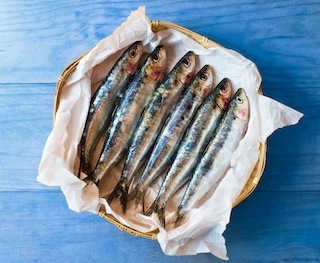 For the most part, your diet seems pretty solid. You’re eating eggs on a regular basis. You’ve got, like, six ways to make really good cauliflower. That subtle humming reverberating through the house is just your chest freezer full of half a grass-fed cow. Leafy green vegetables are staples, sweet potatoes appear post-workout, and you’re first in line to buy fresh wild salmon when in season (plus extra for the chest freezer). All your bases are covered, right? Maybe not. From all the years I’ve been doing this, I’ve spotted a few consistent blind spots in the diets of the Primal community. In today’s article, I will reveal the 10 Primal foods you probably need to eat more often. After each entry, I’ll tell you the easiest (and tastiest) way I’ve found to integrate said food into your diet; no excuses.
For the most part, your diet seems pretty solid. You’re eating eggs on a regular basis. You’ve got, like, six ways to make really good cauliflower. That subtle humming reverberating through the house is just your chest freezer full of half a grass-fed cow. Leafy green vegetables are staples, sweet potatoes appear post-workout, and you’re first in line to buy fresh wild salmon when in season (plus extra for the chest freezer). All your bases are covered, right? Maybe not. From all the years I’ve been doing this, I’ve spotted a few consistent blind spots in the diets of the Primal community. In today’s article, I will reveal the 10 Primal foods you probably need to eat more often. After each entry, I’ll tell you the easiest (and tastiest) way I’ve found to integrate said food into your diet; no excuses.
Let’s get to it:
Chicken liver
Beef (and other ruminant) liver is often called nature’s multivitamin, and for good reason. It provides about a week’s worth of pre-formed vitamin A (retinol) and copper while being perhaps the best source of B-vitamins in town. Only problem? That’s a lot of vitamin A and copper. You can’t, or at least shouldn’t eat it too often. A quarter pound, maybe a half pound per week is just about enough. Any more is probably a bit much. This focus on beef liver also keeps a lot of people from eating what is in many respects a separate yet equal liver: chicken. Lower in vitamin A (but still a fantastic source) and copper, chicken liver can be consumed more regularly than beef liver. Plus, chicken liver is even higher in folate than and about equal in zinc to beef liver.
Another benefit of chicken liver is that it’s relatively mild. Even the liver-averse who’ve tried and failed to enjoy beef or lamb liver often find they can eat chicken liver. Just make sure to choose pastured when available and select the darkest (bordering on burgundy) livers you can find; avoid pale livers.
How to do it: Chicken liver is great sautéed quickly with ginger, shallots, and garlic with a splash of rich chicken stock (reduced to a syrup) and a dash of lemon juice. Salt and pepper to taste.
Brazil nuts
Selenium is a tricky mineral. We need it, but its presence in food depends entirely on its presence in the soil, and there’s kind of a worldwide shortage of soil selenium. So even if the USDA claims lamb liver is rich in selenium, if that animal was grazing on selenium-deficient soil, the liver’s not a reliable source. That’s the thing about Brazil nuts: they hail from a notoriously selenium-replete region. Just a couple nuts provide more than enough selenium.
However, some are scared off by the phytic acid. Others worry about the linoleic acid. Or maybe it’s the radiation, or the mold, or the excessive amounts of selenium. The risks are overblown. Besides, you’re not eating these nuts for the calories. You’re eating one, two, maybe three at a time for the selenium. If you’re looking to maximize your nutrition, these are essential nuts.
How to do it: Eat a small handful a couple times a week, or 1-3 each day. Store in the freezer. Grab Brazil nuts in the shell if possible.
Small oily fish
Small oily fish — sardines, small mackerel, smelts, anchovies — cover just about every Primal base. To wit:
They’re low on the food chain, meaning they’re a more sustainable source of calories and have had less time and inclination to accumulate marine toxins and heavy metals.
They can be consumed whole, meaning they provide calcium (bones), ample micronutrients (fish offal and heads), and all sorts of fermenting goodness (whatever the fish ate, probably algae or something, which makes them vegan I think).
They’re a great source of omega-3s, which we all need even if we’re eating low omega-6. Furthermore, said omega-3s are more stable when consumed in the whole package (the fish).
They’re cheap, at least for now. Don’t wait until the foodies latch on and the price jumps.
Eat them, guys.
How to do it: Salt, pepper, lemon juice, fresh herbs (I like tarragon and/or oregano), olive oil, hot grill, one/two/three minutes a side depending on size.
Blackstrap molasses
It’s a sweetener, yes. It comes from sugar cane, sure. With less sugar than either white sugar, brown sugar, regular molasses, or dark molasses, but far more minerals and electrolytes, this isn’t your mama’s sugar. It’s your great grandpappy’s sugar, the stuff he’d pour slow over his grits or steel-cut oats or cream of wheat or [insert regional porridge]. See, sugar cane is a plant with roots that stretch six meters down into the soil to extract nutrients. It puts hair on your chest, stuffs potassium into your serum, shoves magnesium past your cellular membranes, and makes a killer barbecue sauce. Eating just a couple tablespoons of blackstrap molasses gives you more than twice the potassium of a banana, more calcium than a cup of raw spinach, and almost 100 mg of magnesium. Blackstrap’s got so much potassium that it’s caused hyperkalemia. So don’t go crazy with it. A tablespoon goes a long way.
How to do it: A tablespoon taken straight if brave, mixed with the milk (animal/coconut/almond) of your choice if not. I also use it on the rare occasion I make my energy drink for extreme physical pursuits, which contains raw honey, coconut water, sea salt, and blackstrap molasses.
Extra virgin olive oil
Even though I tried to reassure you folks years ago, some people are still convinced extra virgin olive oil is terrible for cooking, oxidizes as soon as you open the bottle, and contains too many polyunsaturated fats to be good for you. As much as I love coconut oil, macadamia nut oil, grass-fed butter/ghee, and all the others fats the mainstream maligns, I always return to a good bottle of EVOO. Just because it’s a darling of the conventional health community doesn’t mean it’s overrated. It’s not. So here goes:
Olive oil is remarkably stable in the presence of heat.
Olive oil is primarily monounsaturated fat. You can confirm this by sticking your bottle in the fridge. See how it solidifies after half a day? That’s the MUFAs.
Extra virgin olive oil doesn’t oxidize as quickly as you think. And you know how the expensive bottle you just bought burns the back of your throat? That’s not rancidity; those are polyphenols (a good thing!), and they protect the oil from oxidizing.
How to do it: Toss with salads, pour into and drink from teaspoons (slurp to really taste it), use for light to medium sautéing. I’ve even fried thin cut yukon gold potatoes in extra virgin olive oil (the California EVOO from Trader Joe’s, to be exact) and they were great. Didn’t even smoke.
Blueberries
I’m a sucker for blackberries (and really great meaty strawberries), but blueberries aren’t far behind. And in a head to head to head competition, blueberries win out on health benefits. I’ve seen Kaiser Permanente posters that basically amount to close-ups of moisture-flecked blueberries. Everyone agrees these guys are healthy. They’re so good for us that people often use blueberries as a measuring stick for a food’s healthfulness. “Ten times as many antioxidants as blueberries!” the ad for the superfood du jour cries out. Yeah, blueberries can:
Improve blood pressure and arterial stiffness in postmenopausal women with hypertension.
Increase anti-cancer natural killer cell count and reduce arterial stiffness in both sedentary men and women.
Induce anti-inflammatory effects in endothelial cells.
And even if they weren’t so good for us, even if they were just neutral sources of a few calories of fructose and glucose, they are dang delicious. There’s nothing quite like a taut berry exploding between your teeth, coating your tongue with tangy-sweet nectary explosions. ‘Tis the season here in the US, so go get you some.
How to do it: Fresh and in season is best. If you go to farmer’s markets, hit the stands as the market closes for last minute deals. Some stands also give “jam berries” for cut-rate prices. Frozen blueberries are also great and there’s actually interesting research suggesting that the ice crystals in frozen blueberries rupture cell walls and make the anthocyanins more bioavailable.
Oysters
Oysters have a long and storied reputation as potent aphrodisiacs, and there’s something to it. Oysters are the richest source of zinc, a mineral that humans need to make testosterone. If you’re deficient in zinc, eating zinc-rich foods (like oysters) will boost your testosterone level. Red meat is also a good source of zinc, but there’s something special about a half dozen of briny oysters served with lemon. Every time I hit the farmer’s market and the oyster guy’s there, I eat a tray and it just energizes me. Is that peer-reviewed? Nah. But so what.
How to do it: Oyster stew, schmoyster stew. Pop ’em open and eat raw. Trader Joe’s also carries a great smoked oyster in BPA free packaging.
Mussels
Two shellfish on the list, Sisson? What’s the deal here? Is it really necessary?
Yes, and here’s why.
Mussels are one of the better sources of manganese, a mineral that helps oppose iron overload and figures prominently in the production of a vital endogenous antioxidant that protects against the kind of oxidative stress that leads to diabetic complications (whew!). Most people get manganese through whole grain intake, but our pre-agricultural coastal-living ancestors likely obtained their manganese through shellfish consumption. I suggest we do the same. Since you’re probably not eating grains, you should probably eat mussels because you only need an ounce of them, cooked, to hit your daily requirements.
How to do it: I know it can be disappointing when you pay twenty bucks for a bag of beautiful black shells only to end up with shriveled little teaspoons of chewy meat, but they are worth the few minutes it takes to cook the properly. Here’s what to do:
Get some aromatics (garlic, shallots, onoins, leeks, that kinda smelly-in-a-good-way vegetable) and cook until soft in olive oil or butter in a pot.
Add a splash of broth, white wine, coconut milk, hard cider, an orange juice/lemon juice mix, or even just water. Not too much, maybe a quarter cup per pound, as mussels naturally expel a lot of liquid.
Bring to a boil, add mussels, and cover.
Once the mussels start to open, give it another minute or so. Enjoy (and drink the liquid!).
Fermented food
I’m keeping this general because the genre is so broad and not everyone can eat or enjoy dairy or kraut or natto. But everyone can enjoy something. Me? My favorite is a good bowl of grass-fed, full-fat yogurt, possibly littered with blueberries, blackberries, nuts, and sometimes a drizzle of raw honey. I’ll also drink kefir from time to time. When I get around to it, I’ll whip up a batch of sauerkraut and have enough for a few weeks until it runs out and I drag my feet for another few months. If I’m ever in an Asian market, I’ll pick up a jar of kimchi. I also grab natto whenever I see it. My point is I’ve always got something fermented in my fridge, ready to be eaten. Probiotics, even my own, don’t replace them. Why?
Especially when they’re homemade, fermented foods are rich sources of diverse and often unknown strains of probiotics. No batch is the same, so nothing else can replicate it but that specific batch. Some would say that makes it inherently risky, but as long as you’re thriving on the stuff, I’m not worried. Heck, I even like the idea of playing God and creating your own unique strain via natural selection over thousands of generations.
How to do it: Yogurt, kefir, sauerkraut, kimchi, and pickles are relatively easy to make at home. To eat, just, well, eat.
Sea vegetables
Iodine is a Primal bugaboo. Most of you are using fancy pink sea salts without added iodine and avoiding processed food made with standard iodized salt. All good moves, but you still need that iodine. I’m not saying you’re going to suffer from regressive cretinism, but what about your thyroid hormone production? What about the IQ of your gestating child? Sea vegetables, like kelp (kombu) or wakame, are the best sources of iodine in the world. The Japanese eat a ton, so much that their gut bacteria have learned to efficiently digest the otherwise hardy seaweed polysaccharides. Not everyone should eat that much. We should, however, be eating some.
How to do it: Anytime you make broth, add a slab of dried kombu. The iodine and other sea minerals will leach into the liquid.
As I said earlier, these are the dietary blindspots I’m seeing out there. It’s not true for everyone, and your standard Primal way of eating is usually quite complete, but I’d guess that almost everyone out there could use a little more of something from the list.
But let’s hear from you folks: Am I right? Was I wrong? What are the food you see Primal people forgetting to eat?
Thanks for reading, everyone.




Mark Sisson's Blog
- Mark Sisson's profile
- 199 followers



